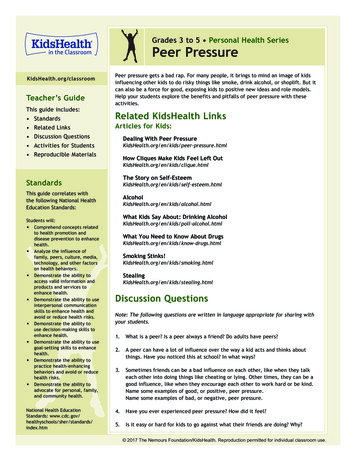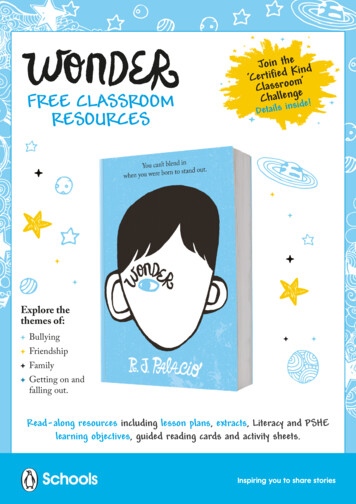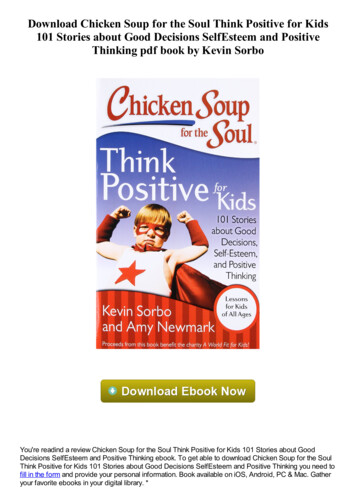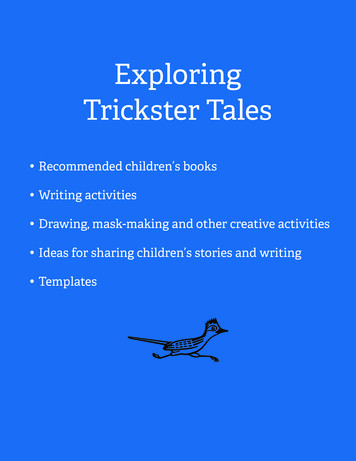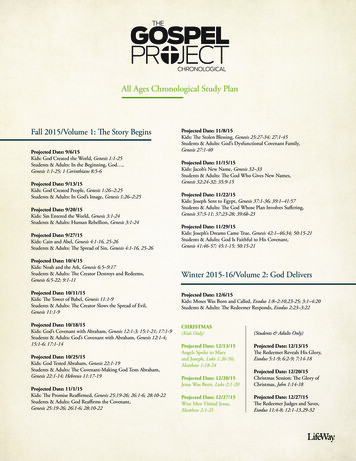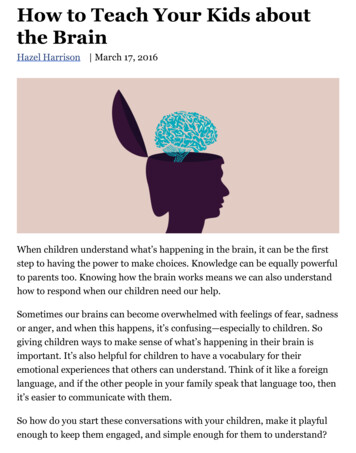
Transcription
How to Teach Your Kids aboutthe BrainHazel Harrison March 17, 2016When children understand what’s happening in the brain, it can be the firststep to having the power to make choices. Knowledge can be equally powerfulto parents too. Knowing how the brain works means we can also understandhow to respond when our children need our help.Sometimes our brains can become overwhelmed with feelings of fear, sadnessor anger, and when this happens, it’s confusing—especially to children. Sogiving children ways to make sense of what’s happening in their brain isimportant. It’s also helpful for children to have a vocabulary for theiremotional experiences that others can understand. Think of it like a foreignlanguage, and if the other people in your family speak that language too, thenit’s easier to communicate with them.So how do you start these conversations with your children, make it playfulenough to keep them engaged, and simple enough for them to understand?
Here is how I teach children (and parents) how to understand the brain.Introducing the Brain House: The Upstairs and theDownstairsI tell children that their brains are like a house, with an upstairs and adownstairs. This idea comes from Dr. Dan Siegel and Tina Payne Bryson’sbook The Whole-Brain Child and it’s a really simple way to help kids to thinkabout what’s going on inside their head. I’ve taken this analogy one stepfurther by talking about who lives in the house. I tell them stories about thecharacters who live upstairs, and the ones who live downstairs. Really, whatI’m talking about are the functions of the neocortex (our thinking brain: theupstairs), and the limbic system (our feeling brain: the downstairs).Who Lives Upstairs and Who Lives Downstairs?Typically, the upstairs characters are thinkers, problem solvers, planners,emotion regulators, creatives, flexible and empathic types. I give them nameslike Calming Carl, Problem Solving Pete, Creative Craig and Flexible FelixThe downstairs folk are the feelers. They are very focused on keeping us safeand making sure our needs are met. Our instinct for survival originates here.
These characters look out for danger, sound the alarm and make sure we areready to fight, run or hide when we are faced with a threat. Downstairs we’vegot characters like Alerting Allie, Frightened Fred, and Big Boss Bootsy.It doesn’t really matter what you call them, as long as you and your childknow who (and what) you are talking about. You could have a go at comingup with your own names: try boys/girls names, animal names, cartoon namesor completely made-up names. You might like to find characters from films orbooks they love, to find your unique shared language for these brainfunctions.Flipping Our Lids: When ‘Downstairs’ Takes OverOur brains work best when the upstairs and the downstairs work together.Imagine that the stairs connecting upstairs and downstairs are very busy withcharacters carrying messages up and down to each other. This is what helpsus make good choices, make friends and get along with other people, come upwith exciting games to play, calm ourselves down and get ourselves out ofsticky situations.Sometimes, in the downstairs brain, Alerting Allie spots some danger,Frightened Fred panics and before we know where we are, Big Boss Bootsyhas sounded the alarm telling your body to be prepared for danger. Big BossBootsy is a bossy fellow, and he shouts: “The downstairs brain is taking overnow. Upstairs gang can work properly again when we are out of danger.” Thedownstairs brain “flips the lid” (to borrow Dan Siegel’s phrase) on theupstairs brain. This means that the stairs that normally allow the upstairs anddownstairs to work together are no longer connected.
Sometimes, Flipping Our Lids Is the Safest Thing ToDoWhen everybody in the brain house is making noise, it’s hard for anyone to beheard. Bootsy is keeping the upstairs brain quiet so the downstairs folk canget our body ready for the danger. Boots can signal other parts of our bodythat need to switch on (or off). He can make our heart beat faster so we areready to run very fast, or our muscles ready to fight as hard as we can. He canalso tell parts of our body to stay very very still so we can hide from thedanger. Bootsy is doing this to keep us safe.Try asking your child to imagine when these reactions would be safest. I oftentry to use examples that wouldn’t actually happen (again so that children canimagine these ideas in a playful way without becoming too frightened bythem). For example, what would your downstairs brain do if you met adinosaur in the playground?Everyone Flips Their LidsThink of some examples to share with your child about how we can all flip ourlids. Choose examples that aren’t too stressful because if you make your kids
feel too anxious they may flip their lids then and there!Here’s an example I might use:Remember when Mummy couldn’t find the car keys and we were already latefor school. Remember how I kept looking in the same place over and overagain. That’s because the downstairs brain had taken over, I had flipped mylid and the upstairs, thinking part of my brain, wasn’t working properly.When the Downstairs Brain Gets It WrongThere might be times when we flips our lids but really we still need theupstairs gang like Problem Solving Pete, and Calming Carl to help us.We all flip our lids, but often children flip their lids more than adults. Inchildren’s brains, Big Boss Bootsy can get a bit over excited and press thepanic button to trigger meltdowns and tantrums over very small things andthat’s because the upstairs part of your child’s brain is still being built. In fact,it won’t be finished being built until the mid twenties. Sometimes, when Iwant to emphasize this point, I ask kids this question:Have you ever seen your Dad or Mum lay on the floor in the supermarketscreaming that they want chocolate buttons?They often giggle, and giggling is good because it means it’s still playful, sothey are still engaged and learning. I tell them parents actually like chocolatejust as much as children, but adults have practiced getting Calming Carl andProblem Solving Pete to work with Big Boss Bootsy and can (sometimes) stophim from sounding the danger alarm when he doesn’t need to. It does takepractice and I remind children that their brains are still building and learningfrom experience.Ultimately, this is about enabling children to learn functional ways tomanage big feelings, and some of that will happen from conversations
about the things that went wrong.From a Shared Language to Emotional RegulationOnce you’ve got all the characters in the brain house, you have a sharedlanguage that you can use to help your child learn how to regulate (manage)their emotions. For example, “it looks like Big Boss Bootsy might be gettingready to sound the alarm, how about seeing if Calming Carl can send amessage saying ‘take some deep breaths.”The language of the brain house also allows kids to talk more freely abouttheir own mistakes, it’s non judgmental, playful and can be talked about asbeing separate (psychologists also call this ‘externalized’) from them. Imaginehow hard it might be to say ‘I hit Jenny today at school’ versus “Big BossBootsy really flipped the lid today.” When I say this to parents, some worrythat I’m giving children a free pass. “Can’t they just blame Bootsy for theirmisbehavior?” they ask. Ultimately, what this is about is enabling children tolearn functional ways to manage big feelings, and some of that will happenfrom conversations about the things that went wrong. If children feel able totalk about their mistakes with you, then you have an opportunity to join yourupstairs brain folk with theirs, and problem solve together. It doesn’t meanthey escape consequences or shirk responsibility. It means you can askquestions like “do you think there is anything you could do to help Bootsykeep the lid on?.”Knowing about the brain house also helps parents to think about how torespond when their child is flooded with fear, anger or sadness. Have youever told you child to calm down when they have flipped their lid? I have. Yetwhat we know about the brain house is Calming Carl lives upstairs and whenBootsy’s flipped the lid, Calming Carl can’t do much to help until the lid isback on. Your child may have gone beyond the point where they can helpthemselves to calm down. Sometimes, parents (teachers or caregivers) haveto help kids to get their lids back on, and we can do this with empathy,
patience and often taking a great deal of deep breaths ourselves!Where to Go from Here?Don’t expect to move all the characters into the brain house and unpack onthe same day; moving house takes time, and so does learning about brains.Start the conversation and revisit it. You might want to find creative ways toexplore the brain house with your child.Here are a few ideas to get you started:1. Draw the brain house and all the characters2. Draw a picture of what it looks like in the house when the downstairsflips the lid3. Find a comic, cut out and stick characters into the downstairs and theupstairs4. Write stories about the adventures of the characters in the brain house5. Use a doll’s house (or if you don’t have a doll’s house, two shoe boxes,one on top of the other works just as well) and fill it with the downstairsand upstairs characters.If you find other creative ways to explore the brain house, I would love to hearabout them.Make it fun, make it lively, and kids won’t even realize they are learning thefoundations of emotional intelligence.Subscribe to support Mindful.
downstairs brain “flips the lid” (to borrow Dan Siegel’s phrase) on the upstairs brain. This means that the stairs that normally allow the upstairs and downstairs to work together are no longe

